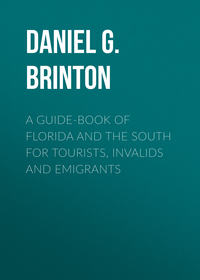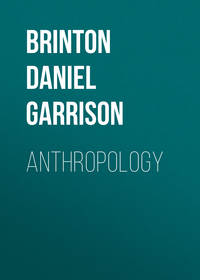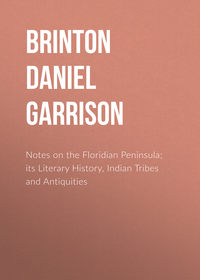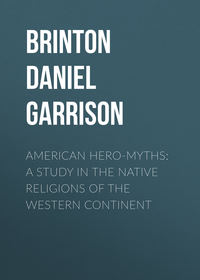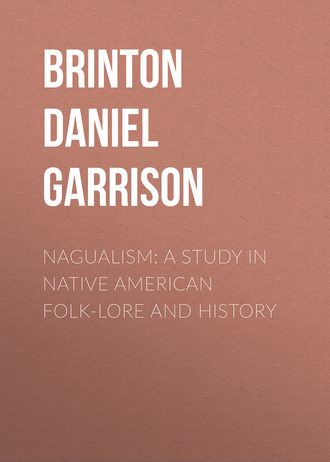 полная версия
полная версияNagualism: A Study in Native American Folk-lore and History
Dr. Eduard Seler has shown beyond reasonable question that this divinity did not originally belong to the Aztec Pantheon, but was introduced from the South, either from the Zapotecs, the Mixtecs, or the Mayan tribes, beyond these.84 The Cave God of the Aztecs is identical with the Votan of the Tzentals of Chiapas, and with the U-q’ux Uleuh of the Quiches of Guatemala, and probably with the Cozaana of the Zapotecs.
The rites of all of these were conducted in caverns, and there have been preserved several interesting descriptions of the contents of these sacred places. That relating to the “dark house of Votan” is given thus in the work of the Bishop of Chiapas:
“Votan is the third hero who is named in the calendar, and some of his descendants still reside in the town of Teopisca, where they are known as Votans. He is sometimes referred to as Lord of the Sacred Drum, and he is said to have seen the great wall (which must have been the Tower of Babel), and to have divided this land among the Indians, and given to each tribe its language.
“They say further that he once dwelt in Huehuetan, a town in the province of Soconusco. Near there, at the place called Tlazoaloyan, he constructed, by blowing with his breath, a dark house, and put tapirs in the river, and in the house a great treasure, and left all in charge of a noble lady, assisted by guardians (tlapiane) to preserve. This treasure consisted of earthenware vases with covers of the same material; a stone, on which were inscribed the figures of the ancient native heroes as found in the calendar; chalchiuites, which are green stones; and other superstitious objects.
“All of these were taken from the cave, and publicly burned in the plaza of Huehuetan on the occasion of our first diocesan visit there in 1691, having been delivered to us by the lady in charge and the guardians. All the Indians have great respect for this Votan, and in some places they call him ‘the Heart of the Towns.’”85
The English priest, Thomas Gage, who was curate of a parish among the Pokonchi Indians of Guatemala about 1630, relates his discovery of such a cave, in which the idol was preserved, and gives this description of it:
“We found the Idol standing upon a low stool covered with a linen cloth. The substance of it was wood, black shining like jet, as if it had been painted or smoked; the form was of a man’s head unto the shoulders, without either Beard or Mustachoes; his look was grim, with a wrinkled forehead, and broad staring eyes.
“They boasted of this their god, saying that he had plainly told them they should not believe anything I preached of Christ, but follow the old ways of their forefathers.”86
The black color here mentioned was a relic of ancient symbolism, referring to the night, darkness, and the obscurity of the holy cavern. Vetancurt informs us that the priests of the ancient paganism were accustomed to rub their faces and bodies with an ointment of fat and pine soot when they went to sacrifice in the forests, so that they looked as black as negroes87 In the extract from Nuñez de la Vega already given, Ical Ahau, the “Black King,” is named as one of the divinities of the nagualists.
In some parts the principal idol found in the caves was the mummied or exsiccated body of some former distinguished priest or chieftain. One such is recorded by Bartholomé de Pisa, which was found among the Zapotecs of Coatlan. It bore a name taken from the calendar, that of the tenth day, and was alleged to be the preserved cadaver of a celebrated ruler.88 Another interesting example is narrated by Villa Señor y Sanchez,89 who describes it as an eye-witness. It was discovered in a spacious cave located some distance to the west of the city of Mexico, in Nahuatl territory, on the side of what was known as “the Sun mountain” —la Mesa de Tonati. He speaks of it as remarkably well preserved, “both the muscles and the bones.”
“It was seated in an armchair which served for a throne, and was clothed in a mantle, which fell from the shoulders to the feet. This was richly adorned with precious stones, which, according to the native custom, were sewed into the texture of the cloth. The figure also wore shoulder straps, collars, bracelets and fastenings of silver. From its forehead rose a crown of beautiful feathers of different colors arranged so that one color should alternate with another. The left hand was resting on the arm of the chair, while in the right was a sharp cutlass with silver mountings. At its feet were several vases of fine stone, as marble and alabaster, in which were offerings of blood and meat, obtained from the sacrifices.”
The same writer refers to other examples of these sacred caves which he had seen in his journeys. One was near the town of Teremendo, where the sides and roof had been artificially dressed into the shape of huge arches. A natural altar had been provided in a similar manner, and on it, at the time of his visit, were numerous idols in the figures of men and animals, and before them fresh offerings of copal and food. Elsewhere he refers to many such caverns still in use as places resorted to by the natives in la gran Sierra de Tlascala.90
These extracts prove the extent of this peculiar worship and the number of these subterranean temples in recent generations. The fame of some of the greater ones of the past still survives, as the vast grotto of Chalcatongo, near Achiutla, which was the sepulchral vault of its ancient kings; that of Totomachiapa, a solemn scene of sacrifice for the ancient priests; that of Justlahuaca, near Sola (Oaxaca), which was a place of worship of the Zapotecs long after the Conquest; and that in the Cerro de Monopostiac, near San Francisco del Mar.91
The intimate meaning of this cave-cult was the worship of the Earth. The Cave God, the Heart of the Hills, really typified the Earth, the Soil, from whose dark recesses flow the limpid streams and spring the tender shoots of the food-plants, as well as the great trees. To the native Mexican, the Earth was the provider of food and drink, the common Father of All; so that to this day, when he would take a solemn oath, he stoops to the earth, touches it with his hand, and repeats the solemn formula: Cuix amo nechitla in toteotzin? “Does not our Great God see me?”
25. The identity of the Tepeyollotl of the Nahuas and the Votan of the Tzentals is shown not only in the oneness of meaning of the names, but in the fact that both represent the third day in the ritual calendar. For this reason I take it, we find the number three so generally a sacred number in the symbolism of the nagualists. We have already learned in the extract from Nuñez de la Vega that the neophytes were instructed in classes of three. To this day in Soteapan the fasts and festivals appointed by the native ministrants are three days in duration.92 The semi-Christianized inhabitants of the Sierra of Nayerit, the Nahuatl-speaking Chotas, continued in the last century to venerate three divinities, the Dawn, the Stone and the Serpent;93 analogous to a similar “trinity” noted by Father Duran among the ancient Aztecs.94
The number nine, that is, 3 x 3, recurs so frequently in the conjuration formulas of the Mexican sorcerers that de la Serna exclaims: “It was the Devil himself who inculcated into them this superstition about the number nine.”95
The other number sacred to the nagualists was seven. I have, in a former essay, given various reasons for believing that this was not derived from the seven days of the Christian week, but directly from the native calendar.96 Nuñez de la Vega tells us that the patron of the seventh day was Cuculcan, “the Feathered Serpent,” and that many nagualists chose him as their special protector. As already seen, in Guatemala the child finally accepted its naual when seven years old; and among some of the Nahuatl tribes of Mexico the tonal and the calendar name was formally assigned on the seventh day after birth.97 From similar impressions the Cakchiquels of Guatemala maintained that when the lightning strikes the earth the “thunder stone” sinks into the soil, but rises to the surface after seven years.98
The three and the seven were the ruling numbers in the genealogical trees of the Pipiles of San Salvador. The “tree” was painted with seven branches representing degrees of relationship within which marriage was forbidden unless a man had performed some distinguished exploit in war, when he could marry beyond the nearest three degrees of relationship.99 Another combination of 3 and 7, by multiplication, explains the customs among the Mixes of deserting for 21 days a house in which a death has occurred.100
The indications are that the nagualists derived these numbers from the third and seventh days of the calendar “month” of twenty days. Tepeololtec, the Cave God, was patron of the third day and also “Lord of Animals,” the transformation into which was the test of nagualistic power.101 Tlaloc, god of the mountains and the rains, to whom the seventh day was hallowed, was represented by the nagualistic symbol of a snake doubled and twisted on itself, and was generally portrayed in connection with the “Feathered Serpent” (Quetzalcoatl, Cuculchan, Gukumatz, all names meaning this), represented as carrying his medicine bag, xiquipilli, and incensory, the apparatus of the native illuminati, his robe marked with the sign of the cross to show that he was Lord of the Four Winds and of Life.102
26. The nagualistic rites were highly symbolic, and the symbols used had clearly defined meanings, which enable us to analyze the religious ideas underlying this mysterious cult.
The most important symbol was Fire. It was regarded as the primal element and the immediate source of life. Father Nicolas de Leon has the following suggestive passage in this connection:
“If any of their old superstitions has remained more deeply rooted than another in the hearts of these Indians, both men and women, it is this about fire and its worship, and about making new fire and preserving it for a year in secret places. We should be on the watch for this, and when in their confessions they speak of what the Fire said and how the Fire wept, expressions which we are apt to pass by as unintelligible, we must lay our hands on them for reprehension. We should also be on the watch for their baptism by Fire, a ceremony called the yiahuiltoca,103 shortly after the birth of a child when they bestow on it the surnames; nor must the lying-in women and their assistants be permitted to speak of Fire as the father and mother of all things and the author of nature; because it is a common saying with them that Fire is present at the birth and death of every creature.”
This curious ceremony derived its name from the yiahuitli, a plant not unlike the absinthe, the powdered leaves of which, according to Father Sahagun, the natives were accustomed to throw into the flames as an offering to the fire.104 Long after the conquest, and probably to this day, the same custom prevails in Mexico, the fumes and odor of the burning leaves being considered very salubrious and purifying to the air of the sick room105
The word yiahuiltoca means “the throwing of the yiauhtli” (from toca, to throw upon with the hands). Another name for the ceremony, according to Father Vetancurt, who wrote a century later than Leon, was apehualco, which has substantially the same meaning, “a throwing upon” or “a throwing away.”106 He adds the interesting particulars that it was celebrated on the fourth day after the birth of the child, during which time it was deemed essential to keep the fire burning in the house, but not to permit any of it to be carried out, as that would bring bad luck to the child.
Jacinto de la Serna also describes this ceremony, to which he gives the name tlecuixtliliztli, “which means that they pass the infant over the fire;” and elsewhere he adds: “The worship of fire is the greatest stumbling-block to these wretched idolaters.”107
27. Other ceremonies connected with fire worship took place in connection with the manufacture of the pulque, or octli, the fermented liquor obtained from the sap of the maguey plant. The writer just quoted, de Vetancurt, states that the natives in his day, when they had brewed the new pulque and it was ready to be drunk, first built a fire, walked in procession around it and threw some of the new liquor into the flames, chanting the while an invocation to the god of inebriation, Tezcatzoncatl, to descend and be present with them.
This was distinctly a survival of an ancient doctrine which connected the God of Fire with the Gods of Drunkenness, as we may gather from the following quotation from the history composed by Father Diego Duran:
“The octli was a favorite offering to the gods, and especially to the God of Fire. Sometimes it was placed before a fire in vases, sometimes it was scattered upon the flames with a brush, at other times it was poured out around the fireplace.”108
28. The high importance of the fire ceremonies in the secret rituals of the modern Mayas is plainly evident from the native Calendars, although their signification has eluded the researches of students, even of the laborious Pio Perez, who was so intimately acquainted with their language and customs. In these Calendars the fire-priest is constantly referred to as ah-toc, literally “the fire-master.” The rites he celebrates recur at regular intervals of twenty days (the length of one native month) apart. They are four in number. On the first he takes the fire; on the second he kindles the fire; on the third he gives it free play, and on the fourth he extinguishes it. A period of five days is then allowed to elapse, when these ceremonies are recommenced in the same order. Whatever their meaning, they are so important that in the Buk Xoc, or General Computation of the Calendar, preserved in the mystic “Books of Chilan Balam,” there are special directions for these fire-masters to reckon the proper periods for the exercise of their strange functions.109
29. What, now, was the sentiment which underlay this worship of fire? I think that the facts quoted, and especially the words of Father de Leon, leave no doubt about it. Fire was worshiped as the life-giver, the active generator, of animate existence. This idea was by no means peculiar to them. It repeatedly recurs in Sanskrit, in Greek and in Teutonic mythology, as has been ably pointed out by Dr. Hermann Cohen.110 The fire-god Agni (ignis) is in the Vedas the Maker of men; Prometheus steals the fire from heaven that he may with it animate the human forms he has moulded of clay; even the connection of the pulque with the fire is paralleled in Greek mythos, where Dionysos is called Pyrigenes, the “fire-born.”
Among the ancient Aztecs the god of fire was called the oldest of gods, Huehueteotl, and also “Our Father,” Tota, as it was believed from him all things were derived.111 Both among them and the Mayas, as I have pointed out in a previous work, he was supposed to govern the generative proclivities and the sexual relations.112 Another of his names was Xiuhtecutli, which can be translated “God of the Green Leaf,” that is, of vegetable fecundity and productiveness.113
To transform themselves into a globe or ball of fire was, as we have seen (antè, p. 21), a power claimed by expert nagualists, and to handle it with impunity, or to blow it from the mouth, was one of their commonest exhibitions. Nothing so much proved their superiority as thus to master this potent element.
30. The same name above referred to, “the Heart of the Town,” or “of the Hills,” was that which at a comparatively late date was applied to an idol of green stone preserved with religious care in a cavern in the Cerro de Monopostiac, not far from San Francisco del Mar. The spot is still believed by the natives to be enchanted ground and protected by superhuman powers.114
These green stones, called chalchiuitl, of jadeite, nephrite, green quartz, or the like, were accounted of peculiar religious significance throughout southern Mexico, and probably to this day many are preserved among the indigenous population as amulets and charms. They were often carved into images, either in human form or representing a frog, the latter apparently the symbol of the waters and of fertility. Bartholomè de Alva refers to them in a passage of his Confessionary. The priest asks the penitent:
“Dost thou possess at this very time little idols of green stone, or frogs made of it (in chalchiuh coconeme, chalchiuh tamazoltin)?
“Dost thou put them out in the sun to be warmed? Dost thou keep them wrapped in cotton coverings, with great respect and veneration?
“Dost thou believe, and hold for very truth, that these green stones give thee food and drink, even as thy ancestors believed, who died in their idolatry? Dost thou believe that they give thee success and prosperity and good things, and all that them hast or wishest? Because we know very well that many of you so believe at this very time.”115
Down to quite a recent date, and perhaps still, these green stones are employed in certain ceremonies in vogue among the Indians of Oaxaca in order to ensure a plenteous maize harvest. The largest ear of corn in the field is selected and wrapped up in a cloth with some of these chalchiuite. At the next corn-planting it is taken to the field and buried in the soil. This is believed to be a relic of the worship of the ancient Zapotec divinity, Quiegolani, who presided over cultivated fields.116
They are still in use among the natives as lucky stones or amulets. In the Zotzil insurrection of 1869, already referred to, one was found suspended to the neck of one of the slain Indians. It came into the possession of M. Maler, who has described and figured it.117 It represents a human head with a curious expression and a singular headdress.
From specimens of these amulets preserved in museums it is seen that any greenish stone was selected, preferably those yielding a high, vitreous polish, as jadeite, turquoise, emerald, chlormelanite or precious serpentine. The color gave the sacred character, and this, it seems to me, was distinctly meant to be symbolic of water and its effects, the green of growing plants, and hence of fertility, abundance and prosperity.
31. There is another symbol, still venerated among the present indigenous population, which belongs to Nagualism, and is a survival from the ancient cult; this is the Tree. The species held in especial respect is the ceiba, the silk-cotton tree, the ytzamatl (knife-leaved paper tree) of the Nahuas, the yax che (green, or first tree) of the Mayas, the Bombax ceiba of the botanists. It is of great size and rapid growth. In Southern Mexico and Central America one is to be seen near many of the native villages, and is regarded as in some way the protecting genius of the town.
Sacred trees were familiar to the old Mexican cult, and, what is curious, the same name was applied to such as to the fire, Tota, Our Father. They are said to have represented the gods of woods and waters.118 In the ancient mythology we often hear of the “tree of life,” represented to have four branches, each sacred to one of the four cardinal points and the divinities associated therewith.
The conventionalized form of this tree in the Mexican figurative paintings strongly resembles a cross. Examples of it are numerous and unmistakable, as, for instance, the cruciform tree of life rising from a head with a protruding tongue, in the Vienna Codex.119
32. Thus, the sign of the cross, either the form with equal arms known as the cross of St. Andrew, which is the oldest Christian form, or the Latin cross, with its arms of unequal length, came to be the ideogram for “life” in the Mexican hieroglyphic writing; and as such, with more or less variants, was employed to signify the tonalli or nagual, the sign of nativity, the natal day, the personal spirit.120 The ancient document called the Mappe Quinatzin offers examples, and its meaning is explained by various early writers. The peculiar character of the Mexican ritual calendar, by which nativities were calculated, favored a plan of representing them in the shape of a cross; as we see in the singular Codex Cruciformis of the Boturini-Goupil collection.
33. But the doctrines of Nagualism had a phase even more detestable to the missionaries than any of these, an esoteric phase, which brought it into relation to the libidinous cults of Babylon and the orgies of the “Witches’ Sabbaths” of the Dark Ages. Of these occult practices we of course have no detailed descriptions, but there are hints and half-glances which leave us in no doubt.
When the mysterious metamorphosis of the individual into his or her nagual was about to take place, the person must strip to absolute nudity;121 and the lascivious fury of bands of naked Nagualists, meeting in remote glades by starlight or in the dark recesses of caves, dancing before the statues of the ancient gods, were scenes that stirred the fanaticism of the Spanish missionaries to its highest pitch. Bishop Landa informs us that in Yucatan the dance there known as the naual was one of the few in which both men and women took part, and that it “was not very decent.” It was afterwards prohibited by the priests. We have excellent authority that such wild rites continued well into the present century, close to the leading cities of the State,122 and it is highly likely that they are not unknown to-day.
34. Moreover, it is certain that among the Nagualists, one of their most revered symbols was the serpent; in Chiapas, one of their highest orders of the initiated was that of the chanes, or serpents. Not only is this in Christian symbolism the form and sign of the Prince of Evil and the enemy of God, but the missionaries were aware that in the astrological symbols of ancient Mexico the serpent represented the phallus; that it was regarded as the most potent of all the signs;123 and modern research has shown, contrary to the opinion long held, that there was among these nations an extraordinary and extensive worship of the reciprocal principle of nature, associated with numerous phallic emblems.124
Huge phalli of stone have been discovered, one, for instance, on the Cerro de las Navajas, not far from the city of Mexico, and another in the State of Hidalgo.125 Probably they were used in some such ceremonies as Oviedo describes among the Nahuas of Nicaragua, where the same symbol was represented by conical mounds of earth, around which at certain seasons the women danced with libidinous actions. Although as a general rule the pottery of ancient Mexico avoids obscenity, Brasseur stated that he had seen many specimens of a contrary character from certain regions,126 and Dr. Berendt has copied several striking examples, showing curious yoni symbols, which are now in my possession.
We may explain these as in some way connected with the worship of Pantecatl, the male divinity who presided over profligate love, and of Tlazolteotl, the Venus Impudica of the Aztec pantheon; and it is not without significance that the cave-temple of Votan, whose contents were destroyed by the Bishop of Chiapas, in 1691 (see above, p. 39), was located at Tlazoaloyan, both names being derived from a root signifying sexual action.127 The other name of the divinity, called “the Heart of the Hills,” is in Quiche, Alom, “he who begets,” and the Zapotec Cozaana, another analogue of the same deity, is translated by Seler, “the Begetter.” Such facts indicate how intimately the esoteric doctrines of Nagualism were related to the worship of the reproductive powers of nature.
35. It will readily be understood from what has been said that Nagualism was neither a pure descendant of the ancient cults, nor yet a derivative from Christian doctrines and European superstitions. It was a strange commingling of both, often in grotesque and absurd forms. In fact, the pretended Christianity of the native population of Mexico to-day is little more than a figment, according to the testimony of the most competent observers.128






